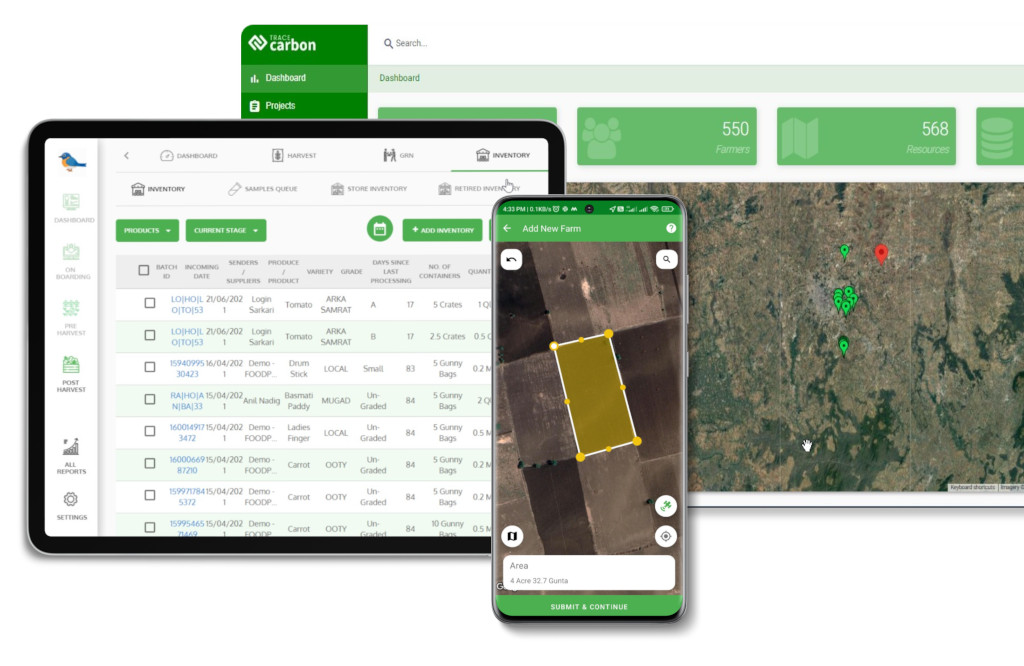Contact: +91 99725 24322 |
Menu
Menu
Quick summary: Discover how OECD seed certification differs from national schemes, why even small producers need digital tools, and how traceability platforms support offline data capture—future-proof your seed operations with confidence.

OECD Seed Certification is an international system that ensures the genetic identity and purity of seed varieties traded across borders. It provides standardized procedures for varietal certification, field inspections, and labeling, facilitating trust and transparency in international seed markets. Managed by the OECD, the scheme is recognized by over 60 countries and supports global agricultural trade.
Because buyers and regulators demand proof—not just claims—of varietal purity, seed health, and traceability. The Organisation for Economic Co-operation and Development (OECD) seed schemes were designed to harmonize international seed certification practices. Whether you’re trading potato tubers, maize, wheat, or pulses, your access to global buyers depends on verified compliance with OECD certification rules—and increasingly, the ability to digitally prove it.
But here’s the challenge, manual records and inconsistent traceability can cause shipment rejections, delays, or even market bans. Competent authorities are tightening inspections and requiring transparent, plot-level data. Exporters are looking for smarter, digital-first ways to track, verify, and report certification data.
Let us see how can technology help meet OECD and phytosanitary export standards?
Key Takeaways
OECD Seed Certification ensures that internationally traded seeds meet strict standards for varietal identity, purity, and traceability. Seed producers must follow rigorous field inspection, documentation, and labeling protocols, which can be complex and time-consuming across geographies. Digital traceability platforms simplify compliance by automating seed lot tracking, certification data capture, and audit reporting—helping producers meet OECD standards faster and with less risk.
The OECD Seed Schemes are international standards designed to ensure that seeds traded across borders are:
Imagine investing in premium seeds, managing multiple farms, and gearing up for international trade—only to have your shipment stuck at customs because it lacked the right certification.
This is where OECD Seed Certification becomes your silent passport to global markets.
If you’re a:
Because buyers and regulators won’t take your word for it anymore.
They need verifiable proof that your seeds:
With global seed fraud, pest outbreaks, and phytosanitary concerns on the rise, OECD certification offers trust, traceability, and trade access—especially in regulated markets like the EU, Canada, and Japan.
That’s where digital traceability solutions come in, giving you field-to-shipment visibility, auto-generated records, and certification-ready reports.
If you’re navigating the maze of international seed trade, OECD certification isn’t just a box to check—it’s your ticket to trusted global markets. But what exactly does “certification-ready” mean in practice?
It all starts with genetic purity. You need to prove that the seed is exactly the variety it claims to be—no mixes, no mislabeling. That means using certified source material and maintaining strict records from the moment the seed is planted.
How do I verify varietal identity?
Through verified planting data, source documentation, and consistent traceability from nursery to harvest. It’s not just about growing the right seed—it’s about proving it.
To avoid cross-pollination and contamination, crops must follow strict isolation distance guidelines. And yes, that means physically removing (aka “roguing”) off-types or diseased plants.
This step often gets skipped in manual records. But under OECD, it’s mandatory—and traceable.
Certified fields undergo official field inspections during the growing season. Every inspection must be documented and linked to a field ID, variety, and date. Field tags or barcoded markers can ensure inspectors and farmers are aligned.
What documents are required for OECD certification?
You’ll need field maps, inspection reports, roguing records, and planting-to-harvest logs—each linked to your seed lot.
Each seed lot must be fully traceable—from field to bag. This means batch numbers, field IDs, input records, and movement logs must be linked in a digital trail.
What is seed lot traceability?
It’s your ability to pinpoint exactly where a seed batch came from, how it was grown, and every step it went through—ready for audit, export, or recall.
No seed lot gets certified without lab-tested data—for purity, moisture, germination rate, and health status. Once cleared, each certified lot gets an official OECD label to accompany it through the supply chain.
Lost your lab report or label history? You may lose the market too.
If you can’t track, you can’t certify. And if you can’t certify, you can’t trade.
Manual logs and Excel files just don’t cut it anymore—especially when compliance depends on real-time visibility, geo-tagged records, and tamper-proof documentation.
Getting certified under OECD Seed Schemes is no walk in the park. Whether you’re running a small seed business or a large export operation, the reality is this: most producers don’t fail because of poor seed quality, but because of poor documentation and traceability.
Still relying on notebooks or spreadsheets? You’re risking your entire seed batch. When records are stored in silos—or worse, misplaced—it’s almost impossible to prove varietal identity, inspection timelines, or field histories during audits.
OECD certification requires that every seed lot be traced back to its exact field of origin. Without digital mapping or batch-level traceability, it’s easy to lose this connection—especially when managing multiple varieties, growers, or seasons.
Field inspections are non-negotiable for certification. But when your planting records, crop stages, and roguing activities aren’t updated in real-time, you risk missed inspection windows or rejection due to non-compliance.
Inspection delays = missed certifications = lost export timelines.
When you’re scrambling through files, mismatched tags, or incomplete roguing records days before an audit, you’re not just stressed—you’re at risk. Auditors want clean, traceable, verifiable data, not excuses.
Platforms like TraceX digitize and streamline every step—from planting records to field inspections to labeling—so your data is always organized, accessible, and audit-ready.
Whether it’s sowing dates, roguing schedules, or lab test results, platforms like TraceX digitize these records at the source—using mobile apps, QR codes, and offline logging.
No more backdated forms or chasing field agents for updates.
With GPS-tagged plots and geo-referenced seed lots, traceability platforms eliminate guesswork.
You’ll know exactly which lot came from which field, variety, and parent line—critical for OECD tagging and audits.
Discover how geo-mapping technology helps agricultural producers track organic inputs, monitor certified plots, and simplify audits—all while ensuring compliance with global organic standards.
Read the Full Case Study to explore how traceability meets transparency in sustainable farming.
Need to prove that only certified inputs were used? Or that isolation distances were maintained?
Traceability tools track inputs and compliance activities as they happen—not weeks later when memory fades.
That’s the kind of transparency certifiers love.
Exporters often ask:
“How do I format my certification records for OECD audits?”
With the right platform, you won’t have to worry. Reports are auto-generated in standardized formats, including seed lot traceability documents, field inspection summaries, and input logs—all backed by timestamps and GPS proof.
What used to take 3 days of prep takes 3 clicks.

If you’re producing certified seed potatoes, you already know how meticulous G0 to G3 production needs to be. Every stage—from planting G0 mini tubers to harvesting G3 lots—must be tracked, verified, and ready for inspection. And yet, many producers still rely on scattered spreadsheets or paper records, increasing the risk of error and certification delays.
Take the case of a certified seed producer advancing G0 mini tubers through G1, G2, and G3. Traditionally, managing this across multiple fields, seasons, and storage units led to:
With a digital traceability platform like TraceX, the entire lifecycle is now connected:
This isn’t just digital for the sake of convenience. It’s digital for faster compliance, stronger traceability, and premium market access.
From Seed to Storage—Traceability That Delivers
See how a leading potato value chain player achieved full visibility across planting, harvesting, procurement, and storage using TraceX.
Read the Case Study to explore how digital traceability boosts quality, compliance, and confidence across the potato supply chain.
With a Digital traceability platform like TraceX, seed producers can now move from siloed spreadsheets to a seamless, compliant, and audit-ready workflow—from sowing to shipment.
Whether you’re working with five farms or 5,000, you can quickly register each grower, assign them fields via geotagged maps, and digitally record every activity—planting, inspections, roguing, and more.
No tech skills needed—just a simple mobile app your team can use even offline.
Every crop has its own certification pathway—especially when you’re working with pre-basic (G0), basic (G1–G3), or certified seeds. TraceX allows you to customize workflows, forms, and data capture templates to match OECD guidelines and local certification schemes.
Forget chasing emails or missing test results. The platform can be linked to certified seed testing labs, government departments, and certification agencies—so your virus tests, purity reports, and lab validations flow directly into your system.
One-click exports = audit-ready reports, instantly.
Your goal isn’t just to tick boxes—it’s to prove compliance, improve quality, and get certified faster, all while expanding into export markets. And with digital traceability, your seed lots don’t just meet standards—they tell a story of trust, transparency, and top-tier performance.
In today’s global seed trade, compliance is no longer a checkbox—it’s your competitive edge. With evolving standards like the OECD Seed Schemes and rising demand for traceability, seed producers and exporters must move beyond manual records and fragmented workflows. A digital traceability solution doesn’t just help you stay compliant—it helps you scale, gain market trust, and unlock new export opportunities.
Ready to turn compliance into a growth advantage? Start digitizing today—and make your seed business future-ready.
OECD seed certification enables international trade by ensuring standardized varietal purity and traceability, while national certification applies only within a country’s regulatory framework.
Yes—digital systems help small producers automate compliance, avoid data loss, and compete in certified seed markets with fewer resources.
Platforms like TraceX allow field teams to log data offline via mobile apps, which sync automatically once internet access is restored.
Learn how to track seed origin, quality, and movement with precision.
From fraud to fragmentation, see what’s holding the sector back—and how to fix it.
Understand how to trace seeds beyond the farm and into final product lines.
Explore how tamper-proof digital records are transforming compliance and audits.
